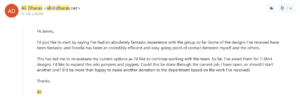BACKGROUND
SPVRO is a startup fashion company that take pride in sourcing from ethical manufacturers and promote social responsibility. They provide fashionable items to consumers and also support orphanages around the world; every item of clothing they sell, they donate an item to an orphanage.
BRIEF
The brief was explained to us by our client, Ali, the founder of SPVRO on the 15th February. He expressed he was in need of t-shirt graphics in order to be printed onto clothing. The client explained that there needed to be a range of creative designs that highlighted SPVRO as a fashion brand with a charitable angle, rather than a charity that sells clothing items. Guidelines given around the content of the designs were very brief, and this gave us a lot of creative freedom when developing ideas. The only preference the client stated was that he personally admired oriental design and mentioned how this could be popular in the target market of males ages 18–26. The only rule we had to follow was to include the SPVRO logo on our t-shirt designs. This logo had been previously designed and was supplied to us at the start of this real job.
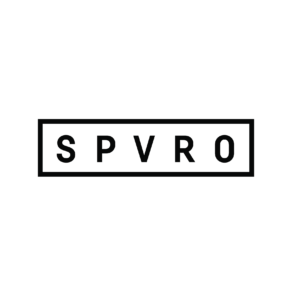
RESEARCH
The client gave us some competitors that we could analyse for design inspiration and understanding of the product. While researching other clothing companies like Friend or Faux and New Wave we discovered that the ‘Oriental/ Japanese street culture’ ‘Miami Vice’ and ‘Indie’ styles were popular.
These styles typically include a-symmetric designs with bright colours in large areas.
This research allowed us to brainstorm imagery that could be associated with the popular styles. All of the members of this real job made various design choices based around these styles and others also explored the brief by creating individual designs and expressing creative freedom.
DESIGN DEVELOPMENT
The first submission of designs was due on the 22nd February, which left members with a week to establish three successful designs. We all had varying design processes which have been detailed below.
LAUREN
Designs were created on illustrator as this software suited the visually complex content. The first design was inspired by the ‘Oriental/ Japanese street culture’ that the client had mentioned in the meeting. It featured an orange circle, reflective of the Japanese flag. This was placed against a dotted, gradient background that provided a frame for the design. In the right hand corner of the dotted background was the Japanese translation for ‘victory’. This design was relatively simple overall but had more detail in individual content, such as the dotted background and the hand drawn Japanese text. The back of this design repeated the dotted background but featured more text content with the English translation of the Japanese text.
The second design was also inspired by Japanese street style. When researching this style I discovered that the use of red circles and Japanese flowers were popular. The second design incorporated both of these things, along with a colourful gradient background. The flowers chosen for the design were Japanese cherry blossom, these were initially hand-drawn and then scanned into illustrator so that I could apply artistic brushstrokes to them, in order to create texture. This was then layered onto a red circle, placed on a gradient square (yellow, orange, red and black). Due to the front of the t-shirt containing a high amount of colour, I felt it important to keep the back of t-shirt simple. This was an opportunity to use the SPVRO logo, so it was placed beneath the neck on the back.
The third design was an opportunity to have a little more creative freedom as I chose to take my own direction and design something different to what had been previously produced. This was a risk, as it did not link to the suggested themes the client had mentioned, however, it was a success and the risk paid off as the client’s feedback was positive. It involved an illustration of two female figures that overlapped, surrounded by words ‘good times’, ‘moves’ and ‘boogie’. This illustration lent itself to high colour. A larger colour palette was used in this design which resulted in an eye-catching design that could potentially fit into the ‘indie’ style category.
I thoroughly enjoyed this real job as it involved a lot of creative freedom and pushed my organisation skills due to the quick deadline. I found that working in a team was effective as I stuck to deadlines and responded to emails promptly. Fenella posed as the leader amongst the designers and made it easy to communicate with her so that we received all the correct information and feedback from Ali, the founder of SPVRO.
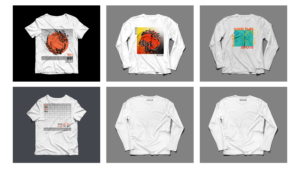
KYLA
All designs were created on illustrator, this programme allowed for detailed illustrations with high quality. The first design I created was a wolf illustration. A wolf represents strength and leadership which are qualities I interpret SPARO to have, due to being one of a few clothing brands who have such and ethical ethos and production. The illustration started by being image traced from a royalty free image to gain a lifelike basis, this was then highly edited to get a free hand drawing feel.
The second design I created was a bit more playful, creating an illustration of angel wings and placing these on the back of the t shirt to recreate where wings would go on the user. Again I used the tool image trace to create a rough realistic base and edited this until happy with the design, duplicating this for a symmetrical and clean outcome. The design outline is in red as this suggests danger or threat creating a contrast to the angel wings which suggest innocence, this playful juxtaposition means there is no one meaning behind the wings.
The third design created fitted the Japanese style suggested. The boxing gloves show power and strength, drawn in a red colour to stand out within the illustration. The Japanese type between the circles reads ‘ethical and sustainable’ to enhance the meaning behind SPARO, but not make it obvious as Ali emphasised the designs should not reflect the brand as a charity. The design incorporates circles as this was an occurring shape seen when researching Japanese fashion. Furthermore Bright and vibrant colours are used to make the design eye catching and stand out.
This Real Job was a good experience as it had a lot of artistic freedom, allowing us to interpret SPARO in our own way and create designs we felt fitted. Working as a group allowed us to give the client a wide range of designs as we all play to different strengths and have different design styles. As a group we worked effectively, all keeping to deadlines to ensure our client got any work timely.
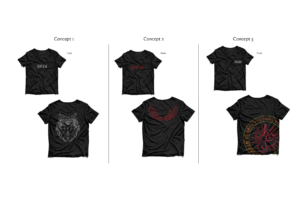
FENELLA
I took on the role of client coordinator throughout this job. This including communicating with the client and organising all of the t-shirt designs into one client facing document which meant all t-shirt designs were presented professionally and consistently to the client. (see figure 1 for layout)
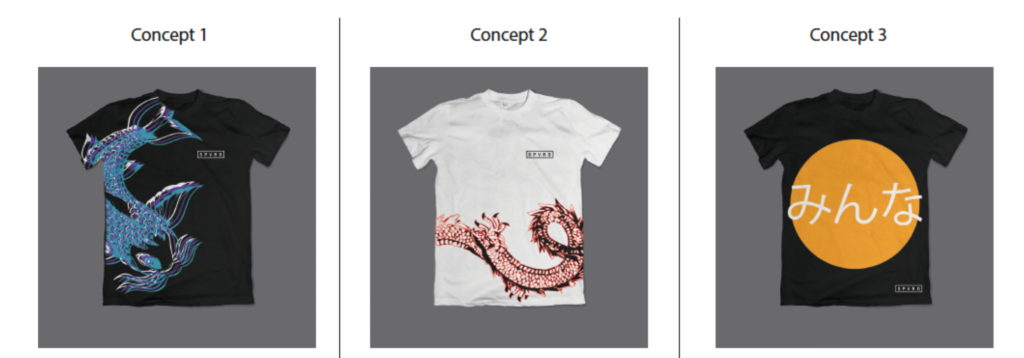
All of designs created were using Adobe Illustrator which were suitable for the detail and complexity of the visuals featured in my designs, the Koi fish and zoom in of an oriental dragon. All three concepts have considered the brief providing my the client, considering the style of oriental X Miami and incorporating elements which are minimalistic and relate to these two themes. When designing I had to take in consideration that the client wanted these designs on either white or black which affected my design including colour choices.
My first design concept was based on the oriental koi fish. I created two final versions of this t-shirt, one featuring the full illustrated visual and the other slightly more zoomed in and cropped. This alters the composition of the design and creates different variations which the client particularly liked. I used bright, vibrant colours which can be linked to the Miami side of the brief. By layering the illustration also added texture to the t-shirt. This design is very versatile and will work on both black and white t-shirts.
My second design was based solely on the oriental theme mentioned in the brief. I chose to focus on the Japanese dragon, particularly looking at the details of the scales which were intricate and added texture. After exploring this, I illustrated the scales, on a zoom in of a dragon’s body. I incorporated the colours; red white and black which can be associated with Japan and their cultural representation. I also designed two variations of this, after feedback from the client. I looked at different compositions between the relationship of the illustration and brand logo to produce two final designs of the t-shirt which the client liked.
My third and final concept combined the two themes, oriental and Miami together. I used simple shapes and a vibrant orange colour to represent the Miami theme and incorporated Japanese typography to incorporate the oriental element of the design. The word chosen to feature in this t-shirt translates to ‘everyone’. This was topical as the client placed an emphasis that the whole production process will be ethical and fair. Although the client did not want this to be immediately obvious in the t-shirts, this subtly represented the brand values of the company and also suggests that this clothing brand can appeal and be worn by a range of people within the target audience.
EMMA
The designs I presented to the client were all produced using Adobe Illustrator, which allowed for high quality artwork. I designed a range of t-shirts which each took an element of the brief given by the client; oriental X Miami. The first design featured a Koi illustration, which is iconic of Japanese and Chinese culture. The word ‘koi’ in Japanese, written as 恋 translates to English as love. This I felt would be appropriate to incorporate into my designs. I initially designed the Koi illustration for a dark blue t-shirt, however with feedback from the client, I then altered designs to print only on black or white material. The Koi is created using a combination of gradient and white outline to create the simplistic yet intricate artwork that can be seen in much of Asia’s culture.
The second series of designs I created showed a more Miami-side of the brief, with bright colours and simple shapes depicting sunsets, which are iconic of oriental pieces of art. The first design in this series is based on Japanese cartoon-like illustration, with simple angled lines suggestive of sunset rays. The second of these designs has a pixelated approach, characteristic of both Asian and Miami gaming styles. This design is also loosely reminiscent of Hokusai’s Great Wave; a famous woodblock print based on Mount Fuji, in Japan. These two designs are relatively versatile as they are able to print on both black or white t-shirts and are neither too masculine, nor too feminine.
I also designed two other sets of t-shirts, which can be seen below. The first design imitates a neon sign along with the company name, which is seen throughout both Miami streets and Japanese cities. The second set of designs are bright bold colours that are reflective of the bright, hot weather in Miami, whilst being suggestive of sun and sea.
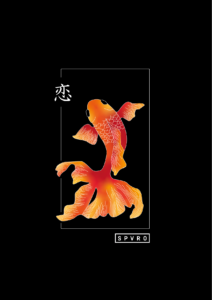
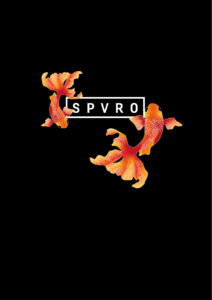
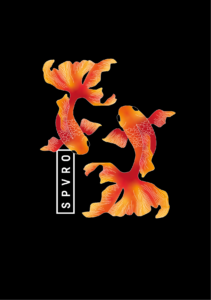

![]()
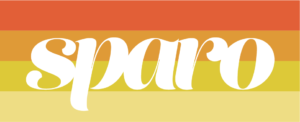
STEPHANIE
My first design took a more simplistic approach. The inspiration behind it drew from Japanese rivers. The silhouette was made using the pen tool in illustrator in order to draw the the area covered by the river. This silhouette was then taken to photoshop where I added a noise texture to it, as you can see in the stand alone picture of the river it is no a smooth texture. Initially, I used a neon purple river on a dark red t-shirt, however Ali had stated after the first feedback that he wanted my designs to be on either a white or black t-shirt and the colours to be more duller. As a result I changed the t-shirt to black and changed the river from a neon purple to a more pastel purple. The use of the pastel purple against the black t-shirt gave it a vibrant look without the use of neon.
My second design drew focus on traditional oriental buildings. I drew out these buildings using a pencil however when I scanned it through it didn’t give me the notion of fine art. It was important for me to carry this through the artwork. I also tried image tracing to no avail. Finally I redrew the buildings in fine liner and when processed through photoshop I was able to get the fine art aspect of the buildings. After this I used the paint tool in illustrator to draw symbols which represented these buildings in oriental culture. These designs were placed on a white t-shirt following the clients feedback of having t-shirts either black or white. I decided that these designs would work best on a white t-shirt due to the use of black lines in the drawings which would be hard to see on a black t-shirt. The Logo was situated only only on the top left, on the front of the shirt.
My final design was the word “wisdom” in Japanese on the front and oriental plant; the Lonicera nitida “lemon Beauty”. The designs again were drawn out by hand and taken into photoshop where I changed the colour to a pastel green on a black t-shirt, as per the client’s request. This real job was very enjoyable in regards to the artistic freedom the client allowed us to express through our design, however it was interesting to see that even though we had artistic freedom we still came across constraints that the client had not previously noted such as t-shirts being black or white.
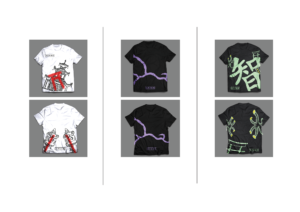
POLINA
I was inspired by Japanese street style (being one of the referencing points client gave to us) and a growing trend for bright colours, especially among the target market of males ages 18–26 (client specifically wanted the designs to be appealing to selected market).
One of the initial ideas included the words “kindness is cool” as a part of the design, however the client rejected it as being too ‘charitable’, and that is something he wanted to lean away from.
From that, an idea of having the artwork on the inside of a T-shirt was born. The concept was interesting in a way that the person buying a T-shirt was helping the charity, but no-one will know that from the T-shirt design, and that was represented in the placement of graphic element – on the inside.
Second idea has made the use of hand-made marks, the visual look of which can be connected to marks made by the brush as when drawing hieroglyphs or in asian-style paintings. Orange is dominant as that colour is strongly associated with the oriental style.
The last design featured overlapping graphic elements with the SPARO logo being the visual centre of the design. The ‘circularity’ of the design can be linked to oriental style and references client has given to us. The chaotic from the first look positioning of graphic elements represents the contemporary trends in fashion.
Overall, the project has allowed for the excess of artistic freedom, which, in my case, proved to be hard to work with as I failed to understand client needs. In case I encounter the similar project with the lack of restraints (as in more conventional graphic design practice) in the future, I will spend more time than usual communication with the client and trying to understand client’s needs and goals.
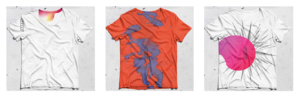
FINAL DEADLINE
Feedback from the client was delayed due to his personal schedule, this set us back a little and therefore the final deadline date was amended so that we could make final changes to our t-shirt designs. Fenella also had to communicate with the client to establish the format he wanted the designs sent in. Once it was established that he wanted the designs on a template of W:370mm by H:460mm we individually created print ready PDFs of out three designs and sent these to Fenella so she could compile them into one document, ready for SPVRO to use. This particular task of sending files to Fenella was something we could have improved, as members of the group delayed the process through missing messages or sending files in the incorrect format.
REFLECTION
On reflection, this real job really pushed independent working as the broad brief promoted creative freedom and forced designers to think ‘outside the box’ instead of following strict guidelines. Although we were working as a group, we produced individual designs which meant that members could give impartial advice on designs which was helpful for everyone. As the deadline was tight, it meant that we had limited time to meet up as a group and therefore most communication was over email or instant message. This meant that messages could be lost or misinterpreted which delayed the design process slightly. However, Fenella was an effective leader as she regularly gave clear instructions over instant message to make sure we had all submitted recent amended designs. The issues that occurred in this real job have been helpful in establishing the correct actions to take in future employment.
Our response from our client, Ali, was very postitive and he seemed grateful for the designs we submitted, he expressed that he would love to work with us in the future if SPVRO release any new clothing items. There is evidence of this below in an email we recieved from Ali.
